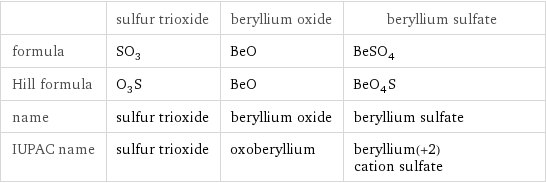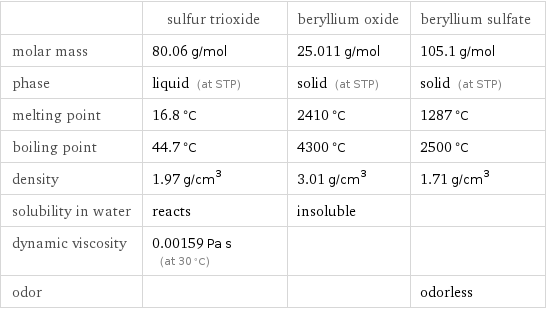Input interpretation

SO_3 sulfur trioxide + BeO beryllium oxide ⟶ BeSO_4 beryllium sulfate
Balanced equation

Balance the chemical equation algebraically: SO_3 + BeO ⟶ BeSO_4 Add stoichiometric coefficients, c_i, to the reactants and products: c_1 SO_3 + c_2 BeO ⟶ c_3 BeSO_4 Set the number of atoms in the reactants equal to the number of atoms in the products for O, S and Be: O: | 3 c_1 + c_2 = 4 c_3 S: | c_1 = c_3 Be: | c_2 = c_3 Since the coefficients are relative quantities and underdetermined, choose a coefficient to set arbitrarily. To keep the coefficients small, the arbitrary value is ordinarily one. For instance, set c_1 = 1 and solve the system of equations for the remaining coefficients: c_1 = 1 c_2 = 1 c_3 = 1 Substitute the coefficients into the chemical reaction to obtain the balanced equation: Answer: | | SO_3 + BeO ⟶ BeSO_4
Structures

+ ⟶
Names

sulfur trioxide + beryllium oxide ⟶ beryllium sulfate
Reaction thermodynamics
Gibbs free energy

| sulfur trioxide | beryllium oxide | beryllium sulfate molecular free energy | -373.8 kJ/mol | -580.1 kJ/mol | -1094 kJ/mol total free energy | -373.8 kJ/mol | -580.1 kJ/mol | -1094 kJ/mol | G_initial = -953.9 kJ/mol | | G_final = -1094 kJ/mol ΔG_rxn^0 | -1094 kJ/mol - -953.9 kJ/mol = -139.9 kJ/mol (exergonic) | |
Equilibrium constant
![Construct the equilibrium constant, K, expression for: SO_3 + BeO ⟶ BeSO_4 Plan: • Balance the chemical equation. • Determine the stoichiometric numbers. • Assemble the activity expression for each chemical species. • Use the activity expressions to build the equilibrium constant expression. Write the balanced chemical equation: SO_3 + BeO ⟶ BeSO_4 Assign stoichiometric numbers, ν_i, using the stoichiometric coefficients, c_i, from the balanced chemical equation in the following manner: ν_i = -c_i for reactants and ν_i = c_i for products: chemical species | c_i | ν_i SO_3 | 1 | -1 BeO | 1 | -1 BeSO_4 | 1 | 1 Assemble the activity expressions accounting for the state of matter and ν_i: chemical species | c_i | ν_i | activity expression SO_3 | 1 | -1 | ([SO3])^(-1) BeO | 1 | -1 | ([BeO])^(-1) BeSO_4 | 1 | 1 | [BeSO4] The equilibrium constant symbol in the concentration basis is: K_c Mulitply the activity expressions to arrive at the K_c expression: Answer: | | K_c = ([SO3])^(-1) ([BeO])^(-1) [BeSO4] = ([BeSO4])/([SO3] [BeO])](../image_source/74853f05fca09d97129396b42d56a3bd.png)
Construct the equilibrium constant, K, expression for: SO_3 + BeO ⟶ BeSO_4 Plan: • Balance the chemical equation. • Determine the stoichiometric numbers. • Assemble the activity expression for each chemical species. • Use the activity expressions to build the equilibrium constant expression. Write the balanced chemical equation: SO_3 + BeO ⟶ BeSO_4 Assign stoichiometric numbers, ν_i, using the stoichiometric coefficients, c_i, from the balanced chemical equation in the following manner: ν_i = -c_i for reactants and ν_i = c_i for products: chemical species | c_i | ν_i SO_3 | 1 | -1 BeO | 1 | -1 BeSO_4 | 1 | 1 Assemble the activity expressions accounting for the state of matter and ν_i: chemical species | c_i | ν_i | activity expression SO_3 | 1 | -1 | ([SO3])^(-1) BeO | 1 | -1 | ([BeO])^(-1) BeSO_4 | 1 | 1 | [BeSO4] The equilibrium constant symbol in the concentration basis is: K_c Mulitply the activity expressions to arrive at the K_c expression: Answer: | | K_c = ([SO3])^(-1) ([BeO])^(-1) [BeSO4] = ([BeSO4])/([SO3] [BeO])
Rate of reaction
![Construct the rate of reaction expression for: SO_3 + BeO ⟶ BeSO_4 Plan: • Balance the chemical equation. • Determine the stoichiometric numbers. • Assemble the rate term for each chemical species. • Write the rate of reaction expression. Write the balanced chemical equation: SO_3 + BeO ⟶ BeSO_4 Assign stoichiometric numbers, ν_i, using the stoichiometric coefficients, c_i, from the balanced chemical equation in the following manner: ν_i = -c_i for reactants and ν_i = c_i for products: chemical species | c_i | ν_i SO_3 | 1 | -1 BeO | 1 | -1 BeSO_4 | 1 | 1 The rate term for each chemical species, B_i, is 1/ν_i(Δ[B_i])/(Δt) where [B_i] is the amount concentration and t is time: chemical species | c_i | ν_i | rate term SO_3 | 1 | -1 | -(Δ[SO3])/(Δt) BeO | 1 | -1 | -(Δ[BeO])/(Δt) BeSO_4 | 1 | 1 | (Δ[BeSO4])/(Δt) (for infinitesimal rate of change, replace Δ with d) Set the rate terms equal to each other to arrive at the rate expression: Answer: | | rate = -(Δ[SO3])/(Δt) = -(Δ[BeO])/(Δt) = (Δ[BeSO4])/(Δt) (assuming constant volume and no accumulation of intermediates or side products)](../image_source/5ab2de7dc33281d26be925ff30fc70a2.png)
Construct the rate of reaction expression for: SO_3 + BeO ⟶ BeSO_4 Plan: • Balance the chemical equation. • Determine the stoichiometric numbers. • Assemble the rate term for each chemical species. • Write the rate of reaction expression. Write the balanced chemical equation: SO_3 + BeO ⟶ BeSO_4 Assign stoichiometric numbers, ν_i, using the stoichiometric coefficients, c_i, from the balanced chemical equation in the following manner: ν_i = -c_i for reactants and ν_i = c_i for products: chemical species | c_i | ν_i SO_3 | 1 | -1 BeO | 1 | -1 BeSO_4 | 1 | 1 The rate term for each chemical species, B_i, is 1/ν_i(Δ[B_i])/(Δt) where [B_i] is the amount concentration and t is time: chemical species | c_i | ν_i | rate term SO_3 | 1 | -1 | -(Δ[SO3])/(Δt) BeO | 1 | -1 | -(Δ[BeO])/(Δt) BeSO_4 | 1 | 1 | (Δ[BeSO4])/(Δt) (for infinitesimal rate of change, replace Δ with d) Set the rate terms equal to each other to arrive at the rate expression: Answer: | | rate = -(Δ[SO3])/(Δt) = -(Δ[BeO])/(Δt) = (Δ[BeSO4])/(Δt) (assuming constant volume and no accumulation of intermediates or side products)
Chemical names and formulas

| sulfur trioxide | beryllium oxide | beryllium sulfate formula | SO_3 | BeO | BeSO_4 Hill formula | O_3S | BeO | BeO_4S name | sulfur trioxide | beryllium oxide | beryllium sulfate IUPAC name | sulfur trioxide | oxoberyllium | beryllium(+2) cation sulfate
Substance properties

| sulfur trioxide | beryllium oxide | beryllium sulfate molar mass | 80.06 g/mol | 25.011 g/mol | 105.1 g/mol phase | liquid (at STP) | solid (at STP) | solid (at STP) melting point | 16.8 °C | 2410 °C | 1287 °C boiling point | 44.7 °C | 4300 °C | 2500 °C density | 1.97 g/cm^3 | 3.01 g/cm^3 | 1.71 g/cm^3 solubility in water | reacts | insoluble | dynamic viscosity | 0.00159 Pa s (at 30 °C) | | odor | | | odorless
Units
